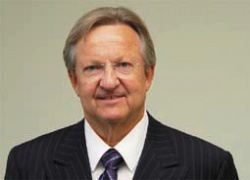Proton therapy: under construction
by Guido Gebhardt
The positive effects of proton rays have been known for years. However, Germany still lacks institutions that utilise those effects.

With the construction of Rinecker Proton Therapy Centres (RPTC) in Munich and Cologne, Hans Rinecker MD, hopes to promote this therapy nationwide – but as yet no firm date is set for their opening. Guido Gebhardt asked what causes the delay and what is the future proton therapy.
Dr Rinecker: The delay has been caused by a part that requires a type of network process where different systems are interfaced. This affects the production and trial of the cyclotron that accelerates protons with a magnetic field. Instead of completion in mid-2004, the centre was finished in May 2006. Afterwards, there was an official acceptance test for the first of five treatment areas; four are exactly the same, one is specialised for eyes and cranium. The test, which included a simulated radiation treatment, was successful – on the whole. The only problem we need to solve is that the system did not process a simulated incident correctly. After a power cut, due to the interruption, the system was unable to remember where to start treatment.
This technical shortcoming can be traced back initially to a key manufacturer in the proton system and, since May, this manufacturer has been pushing up the project costs that we had agreed on to unforeseen levels. It is basically trying to obtain a multiple of the amount that the Technical Inspection Authority – South, which the banks commissioned to monitor the project, has deemed adequate. The costs – about 40.5 million euros, initially envisaged for this part of the project – have now increased to around 70 million euros. We can only guess as to the company’s motive for this. Since then we have been trying to negotiate, but to no avail. Because one of the banks as well as the company in question are based in North Rhine-Westphalia former State Premier Clement is closely following our negotiations.
Surely it is not easy to provide interim funding in the region of 120 million euros over such a long period?
Adding everything up, the sum is closer to 150 million euros, including a patient hotel, which is part of the care concept. In all, five investors are involved in the project, two banks, the West LB AG and HypoVereinsbank Unicredit, and Hanover Leasing and the NRW Bank (the state bank of North Rhine-Westphalia), as well as myself. Of course, it isn’t always easy to keep everyone happy, but the project is well funded and, luckily, my financial background is very stable. At the moment everything is financially safe, but we are losing around one million euros a month.
What will happen in Cologne?
One possibility would be for a third company to finish the centre. However, the company we have chosen – apart from the software problem mentioned earlier – has the most advanced concept by international standards. Changing to another company would entail a loss of know-how. The problem might also be resolved if Dr Clement’s intermediation bears fruit. The third option would be for us to buy parts from one of our present suppliers. We hope to solve this amicably. We are happy to lead a ‘marriage of convenience’. For the moment we have put the Cologne project on hold. Our ideal solution would be to integrate the good components from our present supplier into the Cologne RPTC in cooperation with a significantly more experienced Belgian company. We have not given up hope.
When is the Centre likely to open?
Only the software bug stopped us getting our licence, so everything depends on just this one small issue. As soon as we reach an agreement, we will be under a month away from opening the clinic.
Are you planning further proton therapy centres – in Essen, Kiel and Berlin?
I was recently invited to meet with the Germany Society for Radio-oncology – comprised of radiotherapists who initially were very negative, because they work with linear accelerators. A law introduced in 2001 states that, in all cases, we must choose the therapy that uses the lowest radiation dose – which means proton therapy has an advantage factor of three to five. This means a patient’s healthy tissue only receives a third to a fifth of radiation they’d receive from linear accelerators. Scientifically, we are no longer fighting over proton therapy – everyone agrees it’s only a matter of when it will come. The new centres can only help to promote proton therapy in Germany. To cover the entire nation we’d need 20 centres the size of the RPTC in Munich. The advantages regarding radiation dose are physical, they are not dependent on the types of tumours we treat. There are no scientific reasons why the advantages of proton therapy should be limited to certain types of tumours. Proton therapy will, in time, completely replace radiation with photons.
14.11.2006











